Canaan before the Hebrews
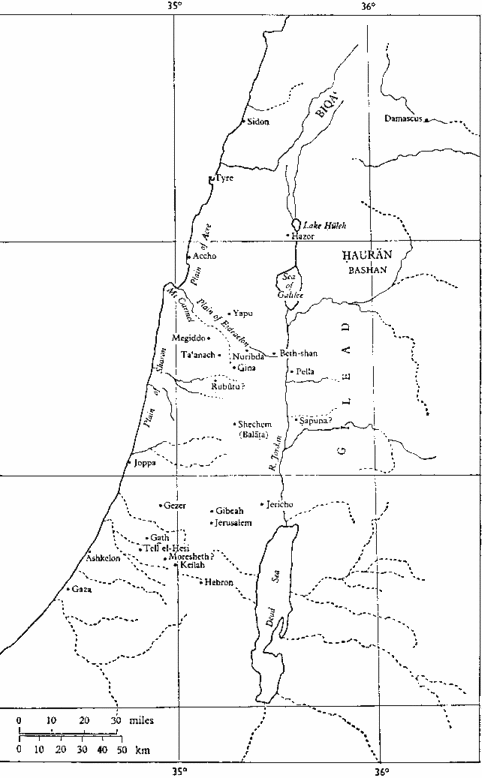
Canaan had been a collection of city-states, tributary to the Egyptian Pharoah, as attested to in the Tel- El Amarna tablets. The breakup of the Egyptian empire beginning about 1500 BCE made possible the invasion of the Hebrews. The map shows the probable location of cities in Canaan about 1200 BCE
.
Israel in Early Times
Israel during the period of the Judges
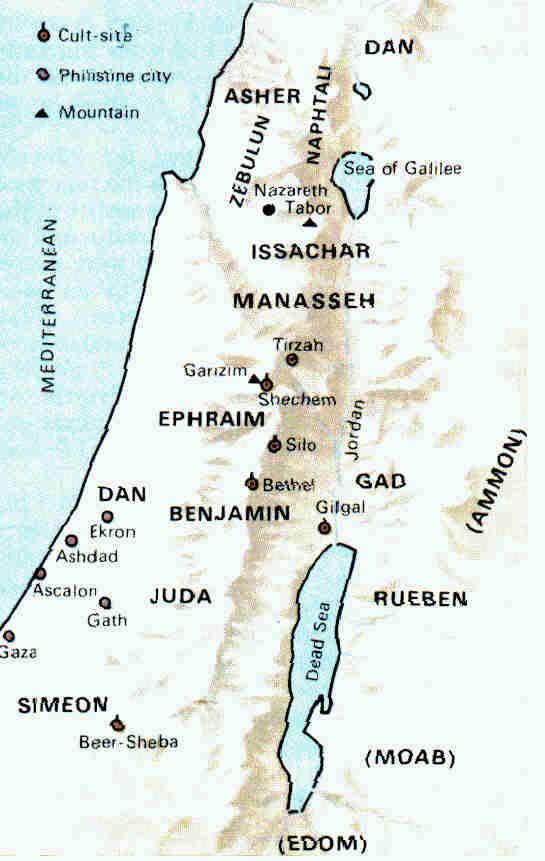
Israel/Canaan during the reign of King David

According to Hebrew tradition, 12 tribes entered Cana'an from Egypt and conquered it, led by Moses. Historical evidence from the Amarna tables suggests that there were already 'apiru' (probably Hebrews) in Canaanites in the time of Egyptian rule, some possibly with names such as "yakubu-el" (Jacob). The biblical account allots different parts of the land to the twelve tribes as shown in the maps. Soon after, a kingdom was established, first under Saul and then under David. The right-hand map shows the borders of the kingdom of David (about 1000 B.C.E. ) and other nations. The maps are necessarily conjectures based on biblical narrative and supporting archeology
The Dual Kingdom and Judea in the Time of Jesus
Israel and Judea
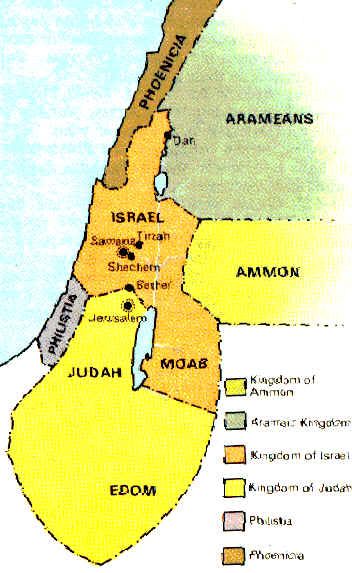
After the death of King Solomon, Israel split into two kingdoms. Eventually, both the kingdom of Israel, and later that of Judea, with its temple in Jerusalem, were overrun by invaders. The Persians restored the Judean kingdom and allowed the Jews to rebuild their temple. This kingdom fell to Greek and later Hellenic-Syrian domination when Alexander the Great conquered Persia.
Israel/Judea about the time of Jesus

In 164 BCE the Hasmonean Kingdom of Judea revolted and became semi-independent of Syria. It was protected by a treaty of friendship with Rome. However in 61 Pompei conquered Jerusalem, and from then on Israel was subordinate to Rome. Parts of it were nominally independent under the rule of local kings of the line of Herod the Idumean.
Maps of Herodian and Roman Filastin
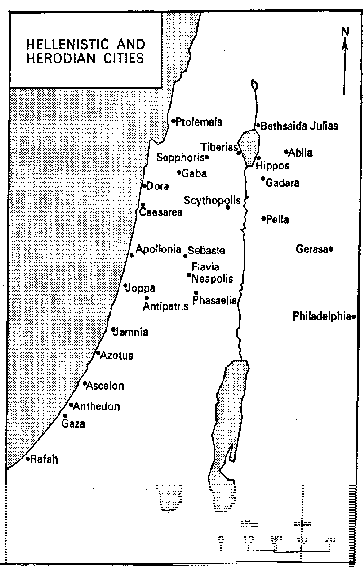
Patriarchate of Jerusalem
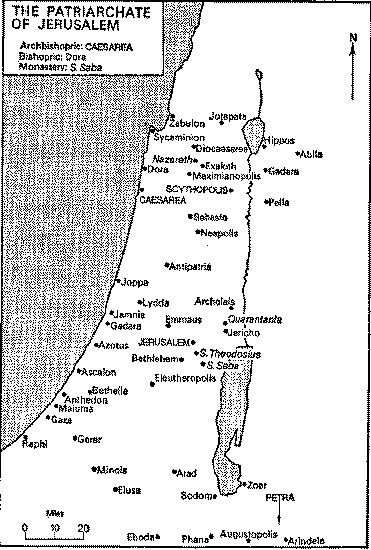
Herod build many towns and fortifications (including Massada and Heordion) and extensively remodelled the temple in Jerusalem. After the first Jewish rebellion and fall of Jerusalem in 70 AD, large numbers of Jews were exiled. Jerusalem was eventually rebuilt as Aelia Capitolina. After the failure of the revolt of Bar-Kochba in 133, there were more exiles and ruined towns. On the ruins of Israelite and Canaanite towns, the Romans built new ones, populated partly by inhabitants of neighboring lands. The land was divided into several districts, of which Israel was only one. The Negev (southern district), generally excluded from these divisions was inhabited by the Nabateans, an Arab trader nation that made a notable desert civilization in cities such as Avdat (in modern Israel) and Petra (in modern Jordan). The whole area between the desert and the sea was known, later in the Roman Empire, as the Christian Patriarchate of Jerusalem, though this was not a Roman administrative division.
Map of Israel under the Caliphs
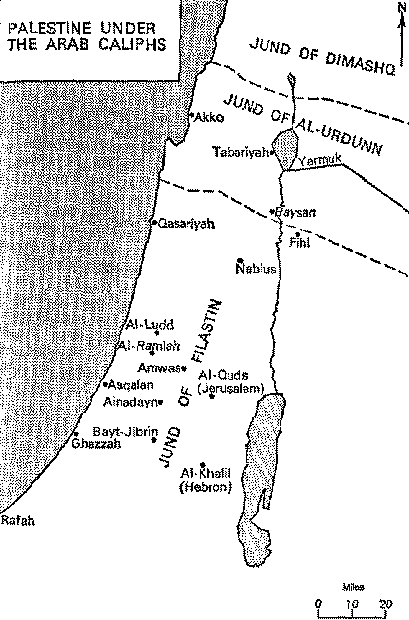
Christian Jerusalem fell first to the Persians, in 614. It was reconquered briefly in 629 by Heraclius. However, with the rise of Islam, the Middle East, and with it - Israel - Canaan - was conquered by Arabs. Jerusalem fell in 640. The Jews were willing allies of the Arabs, as they had been of the Persians. The Land was divided into a Southern Jund (district) of Filastin with a capital in Al-Lud (later in Ramleh), and a northern Jund of Al Urdunn with its capital in Tabariyeh (Tiberius).
(note= Filistin is not quite the same as Palistine)
638
Six years after Mohammed's death, the Caliph Omar enters
Jerusalem and Jews are readmitted to Jerusalem
691
Dome of the Rock completed by Caliph Abd al-Malik
701
The construction of the al-Aqsa mosque completed
by Caliph al-Walid
1010
Caliph al-Hakim orders destruction of synagogues
and churches
Crusader Times
The Latin States
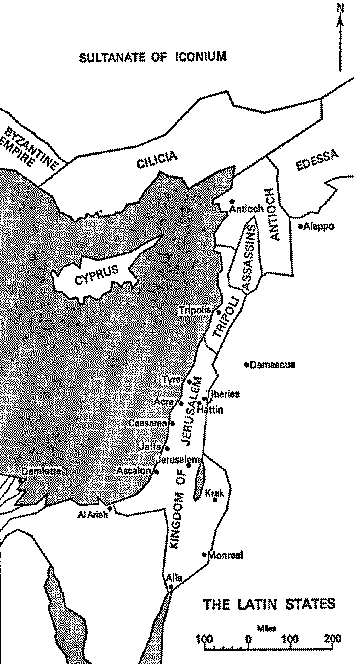
The Crusader Kingdom of Jerusalem
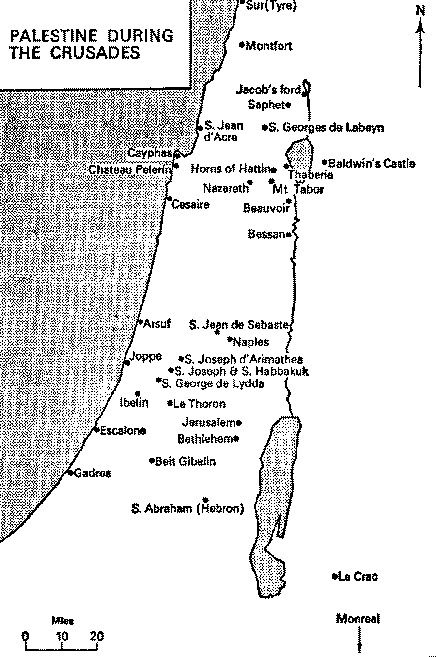
Beginning in 1095, the crusaders conquered Jersalem and the surrounding areas. Initially savage toward Muslims and Jews, crusader rule eventually seems to have brought a measure of good administration before it was eventually eliminated by Salah-e-din and his successors
1099
Crusaders, led by Godfrey de Bouillon, capture of
Jerusalem following Pope Urban's call in 1096.
Baldwin I declared King of Jerusalem
1187
Kurdish general Saladin captures Jerusalem from Crusaders.
He permits Jews and Muslims to return and settle in the city.
1192
Richard the Lion Heart attempts to re-capture Jerusalem
but fails.
Treaty with Saladin permitting Christians to worship at their
Holy sites.
1219
City walls razed by Sultan Malik-al-Muattam
1244
Khawarizmian Turks capture Jerusalem. End of Crusader rule.
Turkish Jersalem and the surrounding areas


Jersalem and the surrounding areas, changed hands several times among Moslem conquerors, the last of whom were the Turks.
1260 — 1517
The Mameluk Period
1244
Mameluk Sultans defeat the Ayyubids and rule Jerusalem
1260
The Mameluks of Egypt capture Jerusalem
1267
Rabbi Moshe Ben Nahman (Nahmanides) arrives from Spain,
revives the Jewish congregation and establishes synagogue and
center of learning bearing his name.
1275
Marco Polo stops in Jerusalem on his way to China
1348
The Black Death Plague hits Jerusalem
1488
Rabbi Obadiah of Bertinoro settles in Jerusalem and
leads the community.
1517 — 1917
The Ottoman Turkish Period
1517
Ottomans effect peaceful takeover of Jerusalem
1537-1541
Unwalled since 1219, Sultan Suleiman ("The Magnificent"),
rebuilds the city walls including the present day 7 gates and the
"Tower of David." The Damascus gate in 1542
.
1700
Rabbi Yehuda He'Hassid arrives, starts building
"Hurva" Synagogue
1836
First visit of Sir Moses Montefiore
1838
First consulate (British) opened in Jerusalem
1860
First Jewish settlement outside walls of the city
1898
Visit by Dr. Theodor Herzl, founder of the World Zionist
Organization.
1917
British conquest and General Allenby's entry into Jerusalem.
1918
Dr. Chaim Weizmann lays foundation stone of
Hebrew University on Mount Scopus.
1920
Sir Herbert Samuel appointed first British High Commissioner
and "Government House" established in Jerusalem.
1918
Early Zionists Reach Out to Arabs
Chaim Weizmann, who would become the first president of Israel, leads the first of several missions to the area to explain the Zionist movement’s aims to the Arabs. He first visits Cairo in March 1918 to meet with leading Syrian Arab nationalists who had been chosen by the British as representatives. Weizmann stresses the Zionists’ desire to live in harmony with the Arabs in Palestine.
1947
United Nations Resolution recommending the partition of Israel.
Since the earliest days of the Zionist enterprise, Jews living in their historic homeland of Israel have repeatedly extended their hand in peace. From its acceptance of the UN Partition Plan in 1947 to its numerous peace overtures toward the Arab states to its offering of more than 90 percent of the West Bank, all of Gaza and a presence in east Jerusalem at Camp David in 2000, Israel has made numerous efforts to coexist in harmony with its Arab neighbors. While Israel has succeeded in achieving peace with Egypt and Jordan, its unflagging efforts to reach such agreements with others, including Syria, Lebanon and the Palestinians, have repeatedly been rejected.
1947
Zionists Accept Creation of Jewish and Arab States
The Jewish community in Palestine accepts the Nov. 29 UN Partition Plan, even though it would have established a truncated, non-contiguous Jewish state without Jerusalem and the Galilee. The Palestinian leadership and Arab governments reject the plan. Their violent effort to destroy the Jewish community is defeated.
1948
Israel Declares Independence Amid Arab Violence
Despite the violent Palestinian campaign against the Jewish community, Israel’s Declaration of Independence of May 14 includes an offer to the Palestinian residents of "full and equal citizenship and due representation." The Declaration states: "We extend our hand in peace to all the neighboring states and their peoples."
1949
Israel Signs Armistice Agreements, Offers Repatriation of Refugees
After Israel wins the War of Independence against the Palestinians and five invading Arab armies, it signs several armistice agreements. These deals include territorial concessions to the Arab countries despite their refusal to sign peace treaties with Israel. The new Jewish state also offers to repatriate 100,000 Arab refugees, to allow the return of family members separated by war, to release refugee accounts frozen in Israeli banks and to pay compensation for abandoned land.
The Arab states reject the offer.
1957
Israel Pulls Out of Egyptian Land
After capturing the Gaza Strip and most of the Sinai from Egypt in October 1956, Israel withdraws from these areas in early March in return for US security guarantees.
1967
Arabs Reject Israel’s Offer to Withdraw From Sinai and Golan Heights
On June 19–just nine days after the end of the Six-Day War–Israel’s cabinet decides to withdraw from the Sinai and the Golan Heights in return for peace. The decision is transmitted through the U.S. government to Egypt and Syria. Both immediately reject the offer.
1968
Israel Accepts UN Call to Withdraw from Territories
Israel’s foreign minister informs the United Nations on Feb. 12 that Israel accepts UN Security Council Resolution 242 of November 22, 1967, which calls on Israel to withdraw "from territories occupied" in the Six-Day War.
1974
Israel Signs Disengagement Agreements with Egypt and Syria
Israel signs a disengagement agreement with Egypt under which it is required to withdraw its forces from positions west of the Suez Canal that it captured during the Yom Kippur War in 1973. In a similar agreement with Syria, Israel withdraws its forces from all the area beyond the Golan it captured, as well as from a narrow strip in the eastern Golan, including its capital, Kuneitra. In both agreements, Israel accepts the imposition of a UN force between it and the two Arab countries.
1975
Israel Withdraws From Strategic Areas of Sinai
Israel signs a second disengagement agreement with Egypt in September. Under the agreement, Israel withdraws its forces from the Suez Canal and a large part of the Sinai, including its oil fields and strategic passes, in return for a three-year non-belligerency pledge.
1978
Israel Signs Camp David Accords with Egypt
At a summit held by President Jimmy Carter at his official retreat, Israeli Prime Minister Menachem Begin and Egyptian President Anwar Sadat sign the Camp David Accords. This landmark agreement is a declaration of principles under which Israel agrees to withdraw from the entire Sinai in return for a peace treaty and to establish autonomy for the Palestinian residents of the West Bank and Gaza.
1979
Israel Signs Peace Treaty With Egypt
Israel signs a peace treaty with Egypt on March 26. The treaty, the first between Israel and an Arab country, finalizes Israel’s commitment to withdraw from the entire Sinai. The Israeli withdrawal is completed on April 25, 1982.
1988
Israel Returns Taba to Egypt
Israel withdraws from Taba, a sliver of land west of Eilat, whose status remained unresolved in the peace treaty. Although Israel built a luxury hotel in the area, it promptly carries out its withdrawal on Sept. 29 when international arbitrators rule in Egypt’s favor.
1993
Israel Signs Declaration of Principles with PLO
Israel signs a declaration of principles with the PLO in a Sept. 13 ceremony featuring the famous handshake between Prime Minister Yitzhak Rabin and Palestinian leader Yasser Arafat. Israel recognizes the PLO and agrees in principle to re-deploy its forces from various parts of the West Bank and Gaza where Palestinian self-government is to be established.
1994
Israel Turns Over Gaza, Jericho; Signs Peace Deal with Jordan
Israel in May agrees to partially implement the Oslo Accords, redeploying from most of Gaza and Jericho. Palestinian political leaders and security forces take over the evacuated areas. In October, Israeli Prime Minister Yitzhak Rabin and Jordan’s King Hussein sign a formal peace treaty and Israel turns over more than 100 square miles of land.
1995
Israel Transfers to PA Authority Over 90 Percent of the Palestinians
Under the Interim Agreement, signed with the PLO on Sept. 28, Israel re-deploys its forces from most West Bank cities and villages. In total, Israel’s forces hand over to the Palestinians 27 percent of the West Bank, which comprises more than 90 percent of the Palestinian population.
1997
Israel Agrees to Turn Over Most of Hebron to the Palestinians
Israel agrees in January to re-deploy from 80 percent of Hebron, Judaism’s second holiest city, negotiate a safe passage for the Palestinians from the West Bank to Gaza and to open a Palestinian airport in Gaza.
1998
Israel Hands Over 40 Percent of West Bank to PA Control
Under the Wye agreement signed on Oct. 23, Israel agrees to a phased redeployment from additional West Bank territory, bringing the total handed over to the Palestinians to 40 percent.
1999
Israel Signs Agreement to Implement Land Withdrawals
Israel signs the Sharm el-Sheikh agreement to implement the Wye accord despite Palestinian violations and to enter into permanent-status negotiations, in which Israel was to make further concessions.
2000
Israel Offers Golan to Syria and Withdraws From Lebanon
Israel, through President Clinton, offers Syria in March a full withdrawal from the Golan to the 1923 international border in return for a peace treaty and security arrangements. Syrian President Hafez Assad rejects the offer. Two months later, Israel unilaterally withdraws from southern Lebanon. The UN confirms that Israel withdrew from all Lebanese territory under Security Council Resolution 425.
Israel Seeks to Reach Final Settlement with the Palestinians
At Camp David in July, Israeli Prime Minister Ehud Barak offers Arafat 92 percent of the West Bank, all of Gaza, Arab neighborhoods of East Jerusalem, Palestinian statehood and the dismantling of most settlements, but he rejects this and the Palestinians launch violence. In December, Barak agrees to negotiate a Clinton proposal for an Israeli withdrawal from 95 per-cent of the West Bank.
Again, Arafat rejects the proposal.
2001
Israel Offers More Concessions
Despite the continuing Palestinian violence, Israeli negotiators, meeting with Palestinian counterparts in Taba, Egypt, agree to go even further than the proposal by Clinton on several key issues. Arafat blocks his negotiators from moving toward an agreement.
Israel Accepts Settlement Freeze Once Violence Stops
NOW
LETS NOT FORGET ARAFAT REJECTED A PEACE PROPOSAL THAT WOULD HAVE GIVEN THE PALESTINIAS 98 % OF THE OCCUPIED TERRITORY,WHERE AS TODAY PALESTINE WOULD HAVE ITS OWN INTERNATIONAL AIRPORT,AND INTERNATIONAL PORT.FOR THE LAST 2% PALESTINE WANT TO NEGOTIATE WITH THE THE ONLY LANGUAGE IT UNDERSTANDS
MURDER AND MAYHEM
MURDER AND MAYHEM BECAUSE OF A MYTHE THAT MOHAMMED DREAMED ABOUT GOING TO A MOSQUE THAT WAS NOT EVEN BUILT
Reinforcing the myth
Despite the often mentioned phrase that "Jerusalem is the third-holiest city in Islam," Islam has never treated Jerusalem as anything other than a slum before modern Zionism. Pictures of the Al-Aqsa mosque from before 1922 show an empty ruin, strewn with weeds and with visible damage
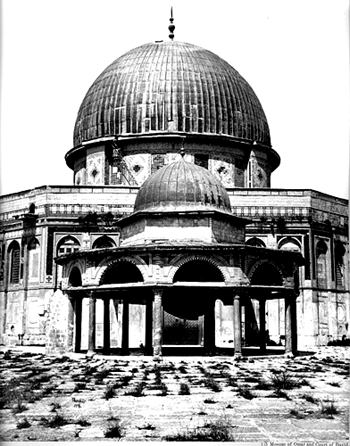 Reinforcing the myth
Reinforcing the mythAs photos and history show, Jerusalem was never a place of pilgrimage in Islam. The politically astute Husayni had ample reason to increase Muslim awareness of Jerusalem and increase his own power. He went on a fundraising tour of the Arab world, saying that he was defending the Al Aqsa Mosque from being destroyed by the Jews.
By the late 1920s he had raised enough money to repair and renovate the Dome, he had increased his influence in the Arab world at large as a real Arab leader, and his prestige among Palestnian Muslims skyrocketed. Not incidentally, he also managed to marginalize his family's major Jerusalem rivals, the Nashashibi family. To a large extent, the myth of the extent of Jerusalem's holiness to Muslims is a direct result of the Mufti's activities in the 1920s.
Incensed at the Jews who continuously flocked to the Western Wall, Husayni created a story that Mohammed tethered his winged horse to the Wall during his mythical "Night Journey" and therefore the Wall itself was a holy Muslim place as well. Palestine's Muslims were more than willing to believe this new claim, and the Mufti knew his audience well enough to be able to incite them to any violence whenever he wanted.
By the late 1920s he had raised enough money to repair and renovate the Dome, he had increased his influence in the Arab world at large as a real Arab leader, and his prestige among Palestnian Muslims skyrocketed. Not incidentally, he also managed to marginalize his family's major Jerusalem rivals, the Nashashibi family. To a large extent, the myth of the extent of Jerusalem's holiness to Muslims is a direct result of the Mufti's activities in the 1920s.
Incensed at the Jews who continuously flocked to the Western Wall, Husayni created a story that Mohammed tethered his winged horse to the Wall during his mythical "Night Journey" and therefore the Wall itself was a holy Muslim place as well. Palestine's Muslims were more than willing to believe this new claim, and the Mufti knew his audience well enough to be able to incite them to any violence whenever he wanted.
1 comment:
Lies Lies Lies, this plog spot is about changing facts, israel will be destroyed one day and it is based on a punch of lies.
Post a Comment